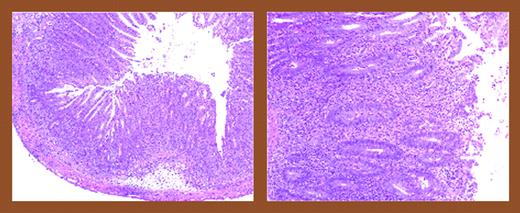Comment on Tivol et al, page 4885
The immunologic response to foreign alloantigens in graft-versus-host disease can lead to the breakdown of self-tolerance precipitating autoimmunity.
Graft-versus-host disease (GVHD) is a major life-threatening complication of allogeneic bone marrow transplantation (BMT). Initially presenting as an acute inflammatory response, GVHD can evolve into a chronic disease that shares many characteristics with several autoimmune disorders. In this issue of Blood, innovative research by Tivol and colleagues reveals that immune tolerance to self-antigens is broken during GVHD with the emergence of autoreactive T cells capable of mediating disease.FIG1
Colitis is characterized by extensive infiltration of T cells and granulocytes. See the complete figure in the article beginning on page 4885.
Colitis is characterized by extensive infiltration of T cells and granulocytes. See the complete figure in the article beginning on page 4885.
During the past decade, considerable progress has been made in elucidating the pathophysiology of acute GVHD. Following allogeneic BMT, a graft-versus-host reaction is initiated when donor T cells transferred along with the bone marrow graft directly recognize alloantigens presented by the antigen-presenting cells (APCs) of the host. The activated donor antihost-specific T cells expand in the developing “cytokine storm,” resulting in tissue destruction that is normally limited to the skin, liver, and intestinal tract as the target organs.1 Host APCs are also destroyed during the initial phases of acute GVHD.
The underlying immune mechanisms responsible for chronic GVHD, however, have remained controversial. Chronic GVHD usually develops after an episode of acute GVHD but may also occur de novo.2 Comparatively, chronic GVHD has discrete clinical features resembling a variety of collagen vascular disorders, including Sjogren syndrome and scleroderma. These clinical manifestations led to the hypothesis that chronic GVHD is an autoimmune disorder. The detection of autoreactive T cells of donor origin (donor-antidonor reactivity) following allogeneic BMT in human and in murine systems further supported this premise.
In an elegant series of studies, Tivol et al confirm this hypothesis, providing direct evidence that CD4+ autoreactive T cells of donor origin emerge during GVHD. These cells, which recognize self (donor) major histocompatibility complex (MHC) class II antigens, target the colon when adoptively transferred into naive donor strain recipients. The pathologic damage is consistent with autoimmune colitis. Cells of the innate immune system (granulocytes) appear to play a significant role in this autoimmune process. Moreover, the studies by Tivol et al also reveal that there is a disparate requirement for host and donor APCs in acute and chronic GVHD. Although host APCs are required for the initiation of acute GVHD, donor APCs play a central role in both the progression of acute GVHD and the development of chronic GVHD. These APCs present both donor and host antigens to the engrafted donor T cells, allowing for the activation of alloreactive and autoreactive T cells. However, it remains unclear whether the autoreactive T cells arise due to thymic damage during acute GVHD (compromising negative selection) or due to the cross-presentation of self-antigens. Nevertheless, the research from Tivol et al provides not only important insights into some of the underlying immune mechanisms involved in acute and chronic GVHD, but also emphasizes the importance of establishing tolerance to both host and donor antigens after allogeneic BMT. ▪


This feature is available to Subscribers Only
Sign In or Create an Account Close Modal